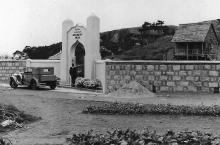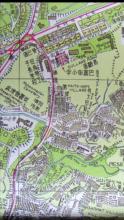Current condition
Demolished / No longer exists
Date completed
(Day, Month, & Year are approximate.)
Date closed / demolished
(Day, Month, & Year are approximate.)
You can see this on the 1949 map, marked 'Mohammedan cemetery'. It must have been cleared since then though, as now it is the site of several buildings.
Booth found the skeleton of a snake there, and notes the unusual shape of the graves. He was given the following explanation by one of the staff at the Fourseas Hotel:
"The graves are those of people of Islam. They did not worship God or Buddha, but Allah. Many of them were Indian soldiers in the British Army a long time ago when the soldiers camped on the hills of Kowloon. Some were merchants. It is a very unlucky place,' he continued. "You see how the squatters do not build near there? There are many restless ghosts".


Comments
Photos of Kowloon Muslim cemetery taken in 1934
Some photos recently uploaded to Flickr:
http://flic.kr/p/9y2Ygj
http://flic.kr/p/9yewNZ
http://flic.kr/p/9yeGiz
re: Photos of Kowloon Muslim cemetery
I wasn't expecting to see any photos of this, so thanks for posting them.
Regards, David
Looking at the records for
Looking at the records for this small Ho Man Tin Muslim Cemetery, a lot of the bodies were exhumed in the three months of February-April 1967 and transfered to the Muslim Cemetery at Cape Collinson. The last body exhumed with a record was 3rd April 1967 and this should give an estimate of when the cemetery ceased to function. Despite strong Chinese superstition, its funny how at the end of the day, the pragmatic Hong Kong need to make money by making use of the land for property development just trumps everything.
"The Cape Collinson Mosque was also built under similar demands of urban renewal and because of the reclaiming of land belonging to a cemetery and a small mosque in Ho Man Tin on the Kowloon peninsula in 1963. The government, therefore, constructed a small mosque on Cape Collinson, opening it on 4 August 1963."
Source: Page 32, Islam and China’s Hong Kong: Ethnic Identity, Muslim Networks and the New Silk Road by Wai Yip-Ho (2013) published by Routledge
1921
"In 1930, the 'Kowloon Cemeteries' in Ho Man Tin, authorized in 1921, were split into three separate ones and were renamed, together with Sai Yu Shek Cemetery:...
...To be known as Kowloon Cemetery No.3, the piece of land containing about 5.5 acres situated at Ho Man Tin in Kowloon in the Colony of Hong Kong and to be use as a Mohammedan cemetery"
Source: Page 256 A review of Development of Cemeteries in Hong Kong: 1841-1950 by Ko Tim-Keung Journal of the Hong Kong Branch of the Royal Asiatic Society Volume 41 (2001) pp 241-280
The nearby Harrison Court's
The nearby Harrison Court's date of occupation was from 16th September 1963 according to centadata.
The nearby Tak Wai Mansion's date of occupation was from 17th July 1965 according to centadata.
The nearby Yu Chun Keung Memorial College was established in 1975 according to its website.
“Another cemetery which the
“Another cemetery which the Muslims had established in Hong Kong was at Ho Man Tin. This was the result of the Muslim soldiers of the Hong Kong Regiment of the British Army request to their Commanding Officer to allocate them a separate place for the burial of their dead bodies in Kowloon Peninsula. The Commanding Officer accepted their request and temporarily allotted them a piece of land in the Ho Man Tin Hill, just behind the present Pui Ching School on Waterloo Road. The Muslim forces with volunteers on every Sunday used to go to the site to develop it as cemetery. They also constructed a small mosque in the cemetery for funeral prayers. Besides that they dug out a well which could be used for ablution and drinking. The fresh water of the well became an attraction for all inhabitants of Ho Man Tin and they used to come to fetch the water from the well. The cemetery and mosque were named as “Moro Garden” for its enthralling view and fresh drinking water.
The Ho Man Tin Muslim cemetery having 50 graves was handed over to the Indian Muslim Society in 1930. The Society for the repair of the cemetery small gate, construction of the boundary wall and a small monument at its entrance started a subscription of 10 cents per member. Initially it was allotted for the burial of Muslim soldiers in the British army but after “… the Second World War, it was opened for the use of all Muslims in Hong Kong, and operated until it was closed in 1961 and the bodies subsequently exhumed and transferred to the new Muslim cemetery in Cape Collinson on Hong Kong island in 1972”.
Source: “The Muslims of Hong Kong and their Religious Symbols”, Peshawar Islamicus Vol:7, Issue 1 page 50 Jan-June 2016 by Syed Minhaj ul Hassan
So by 1930 there were already 50 graves, so it seems to have been in use from 1921 by the military for Muslim soldiers, closed for further burial in 1961 and the last body exhumed in April 1967 for transfer to the cemetery in Cape Collinson.
Edit:
I have since combed the Ho Man Tin cemetery records and found one outlier of data - the last body exhumed and transferred to Cape Collinson cemetery was 13th September 1967.
Interesting to note that the last burial available to view on-line (familysearch.org) took place at the Ho Man Tin Muslim Cemetery on 12th January 1962. Thereafter the records stated "Burial after 1962, please see new register" which is unfortunately not available on-line to view, suggesting that burials continued well into the 1960s.
Browsing through Mike Cussan
Browsing through Mike Cussan's photos showed a view of Ho Man Tin hill from 1966. With an eye of faith I think I can make out the bulbous white gateway/entrance to the Muslim Cemetery in the photo.